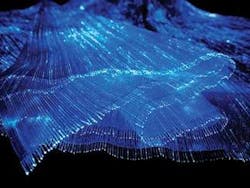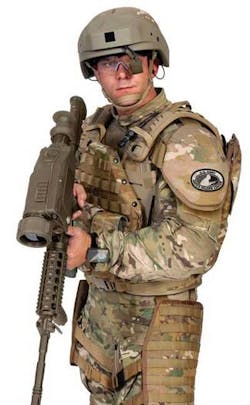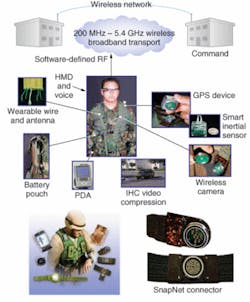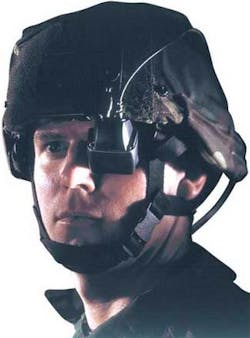OPTOELECTRONIC APPLICATIONS: Defense & Security: Photonics streamline next-generation battlewear
Smart fabrics that integrate optical components into the weave of the material to facilitate the dissemination of critical or creative data are attracting much attention these days. The Lumalive technology developed by Philips Research Laboratories (Eindhoven, The Netherlands), for example, integrates flexible arrays of multicolored LEDs into fabrics that can be used in clothing for promotional events, entertainment, and workplace safety. Luminex (Prato, Italy) has developed a proprietary method for weaving fiber optics into fabric that makes a stunning fashion statement, but also holds promise for next-generation apparel worn by soldiers, police officers, firefighters, and other users of “tactical information” (see Fig. 1).
“These are plastic fiber optics that are doped so they can be pressure treated and etched, allowing the light to emit from the sides of the fiber,” said Chris Berger, North American representative for Luminex. “We have had conversations about this technology with people in a number of militaries worldwide and with companies that develop safety equipment (uniforms and helmets) and related applications.”
In fact, although the initial buzz involves the impact of these technologies in the consumer space, a number of military and commercial groups are working to create new kinds of wearables that utilize optics, fibers, and optoelectronics to enhance safety and communication for individuals in mission-critical field situations. In the United States, the Future Force Warrior (FFW) program is at the forefront of the military’s work in this direction.1 Similar programs are taking place in other countries, including Slovenia’s 21st Century Warrior, Australia’s Land 125, Portugal’s Soldado do Futuro, FELIN in France, the Swedish Markus program, Germany’s Infantryman of the Future, the U.K.’s Future Infantry Soldier Technology project, and Israel’s Advanced Infantry System program. In each case, the focus is on bringing advanced communication and logistical tools to the soldier in the field—a concept known as “soldier as system,” according to Dutch Degay, equipment specialist with the FFW program at Natick Army Research Center (NARC; Natick, MA).
“We are taking lessons learned from Afghanistan and Iraq and looking at new and emerging technologies and weaving them together to build the next-generation soldier system (see Fig. 2),” Degay said. “We are looking at new kinds of body armor, the material of the uniform, how to integrate and utilize the onboard computer, eyewear, weapons systems, network access and other communications, physiological monitoring, power systems, energy harvesting . . . we see the soldier as a system of systems—an F‑16 on legs, so to speak.”While the goal is to use cutting-edge technologies to give soldiers in the field every advantage possible—referred to as “situational awareness”—other critical factors must also be taken into consideration, such as how much weight can realistically be carried and the need to keep hands on weapons at all times. The typical soldier in Iraq today carries an average of 120 lb on his or her back, with batteries one of the biggest contributors to this load (30 to 50 lb alone). These batteries are necessary to support all of the various electronic gadgets the soldier needs while in the field, including GPS devices, PDAs, cell phones, radios, displays, and the wires and controller units that integrate the data that is sent and received by these varied data systems. Thus, military and commercial engineers have begun to work more collaboratively to create battlewear that better integrates all of these devices from the get-go, with four key factors in mind: size, weight, power, and cost.
“One of the flaws in the development of components has been that you had a helmet developer, or a white-light developer, or a body armor developer, all working from independent requirements,” said Sean Martin, senior vice president of business development at Armor Holdings, which is commercializing a nano-based body-armor technology being evaluated through the U.S. Land Warrior program.2 “No one was developing the soldier as a system; everything was just added onto the individual like a Christmas tree. What we are doing now is approaching this like a system: if you add a capability, you don’t add a burden; rather, you modify the approach and reconfigure the system.”
Personal area networks
Thus, optical fibers, infrared cameras, OLED displays, and photovoltaics are attracting the attention of military R&D projects not only for their technical advantages but also their tendency to be more lightweight and robust in the field (see “OLEDs enhance helmet-mounted displays”). For example, while still a little tricky to work with, fiber optics woven into fabrics offer some key advantages over more standard wiring for such applications as high-rate data transfer around the body (for example, from a soldier’s computer to the head-up display), according to James Fairneny, an electrical engineer working with the Multifunctional Materials Team at NARC.
“We have been trying to integrate copper wires and fiber optics into different fabrics, both in the weaving process itself and in the seams of the fabric during construction of the garment,” he said. “With fiber optics you don’t need the EMI shielding required for regular copper wire because they inherently are not susceptible to EMI interference, which could reduce the bulk in a cable assembly to be integrated into the fabric of the uniform.” At the same time, however, fiber optics can be more fragile and pose some unique challenges in the manufacturing process of textiles, he added—notably, “bendability.”
Researchers at the Institute for Soldier Nanotechnologies at Massachusetts Institute of Technology (Cambridge, MA) are working to improve optical-fiber technology for smart fabrics. Materials scientist Yoel Fink and physicist John Joannopoulos are fabricating novel sensor fibers that can sense changes in body surface temperature and determine whether a soldier is being targeted by a laser. They are working with amorphous semiconductor arsenic selenide for the fiber core, with parallel contacting wires made out of tin and polyethersulfone polymer for insulation. To detect a specific color of light, a dielectric stack-reflecting layer is incorporated into the fiber; the reflector contains a cavity that allows only light of a certain wavelength to pass through to the core, and particular colors are detected via a drop in the semiconductor core’s electrical resistance. The same approach works for temperature sensing, only the core material is chosen so that temperature variations change its resistance.
Taking this notion one step further, NARC is also collaborating with companies such as Physical Optics (Torrance, CA) to build lightweight wearables that enable soldiers in the field to function as “personal area networks” (PANs). Among other things, engineers at NARC have been evaluating a polymer guide-light array developed by Physical Optics for a flexible display that could be integrated onto the textile for an extra display on the soldier’s sleeve or the interior of a tent for map reading.
But the guide-light array is just one element in Physical Optics’ extensive portfolio of optoelectronic systems developed for military applications; other products include Wearnet, a personal area network that enables bilateral communication between a soldier and command central (see Fig. 3). Wearnet is configured as a harness with a garment underneath that contains sensors for physiological and other monitoring applications; Snapnet functions as the system’s connector, integrating all the wires, batteries, and gadgets—even weapons—in a simple optoelectronic device that serves as an electrical and data link. There is also Starnet, a self-healing autonomous network system embedded in the harness that can reconfigure itself if the wires are clipped, ensuring that communication is never lost. The company is even working with free-space optics for wireless communications and to help soldiers detect enemies and objects.“The real story is that this is a wearable PAN, and the entire system weighs just 25 lb,” said Rick Shie, senior vice president at Physical Optics. “In the future, our soldiers become nodes; when they are out on a mission they are constantly collecting data and transmitting that data from one soldier to the next and back to headquarters. We are also looking at different harnesses with conductive fibers in the fabric so we can rivet the snaps onto the cabling anywhere on the garment and attach all of these items; eventually you will even be able to embed a body-formable PDA into the clothing.”
Power up, weight down
But no matter how efficient, lightweight, and streamlined the design, each of these capabilities requires power to make them work. According to the military, the need is for a compact, lightweight battery that can power all the system electronics for eight to ten hours, and there is ongoing work to improve the lifetimes of conventional lithium batteries. Other efforts are focused on renewable energy sources for field-based soldiers. Some involve fuel cells and methanol canisters, others kinetic harvesting; in the latter, the focus has been on “heel-strike” generators, powered through the pumping motion of a footstep, that can be embedded within a boot heel, generating 3 to 6 W of output power.3
Konarka (Lowell, MA)—and renewable-energy competitors such as Iowa Thin Films (Ames, IA)—is taking a different approach with its flexible photovoltaics.4 The company has developed nano-enabled polymer photovoltaic materials that can be printed or coated onto plastic substrates, resulting in lighter, more-versatile solar materials, according to the company. Konarka says its “Power Plastic” technology has a power-to-weight ratio six times higher than other thin-film solar alternatives, and is more sensitive to moderate and low light levels (even indoors), allowing it to produce more energy throughout the day and in shaded or overcast conditions. The company has collaborated with the U.S. Navy and DARPA and currently has a $1.6 million contract with the U.S. Army, which is hoping to turn Konarka’s panels into power-generating tents, uniforms, and even backpacks, enabling soldiers to stay out on missions longer.
But some hurdles remain, according to DeGay, such as the reflective nature of photovoltaic material, which can make a soldier a more visible target on a sunny day in the desert. In addition, a solar-powered system might not work as well in shady jungle environments. Even so, an ongoing U.S. military-sponsored Science and Technology Objective is focused on developing self-powered electrotextiles that can achieve photovoltaic power generation from virtually any surface.
REFERENCES
1. C.E. Howard, Military & Aerospace Electronics (July 2006).
2. M. Arndt, Businessweek (Aug. 7, 2006).
3. C. Price, “Charging up the stairs,” www.news.bbc.co.uk (May 2006).
4. C. Biberdorf, The Warrior (November 2004).
OLEDs enhance helmet-mounted displays
Optics have long played a part in military equipment for display and imaging purposes. Now advances in OLED technologies are enabling next-generation helmets and microdisplays that can further enhance the viewing and data-access capabilities of soldiers in the field—and still satisfy the “size-weight-power-cost” performance criteria required by the armed forces.
“OLED displays have risen to the top in terms of customer evaluations in the Land Warrior and Future Force Warrior programs,” said Richard Coupland, business area manager in the Warrior Systems business at General Dynamics C4 Systems (Scottsdale, AZ), lead integrator on the Land Warrior project. Among other things, General Dynamics is sponsoring research at the Flexible Display Center at Arizona State University (Tempe, AZ) involving new lightweight, low-power displays.
“Displays are obivously important, but no one wants to light up a Palm Pilot and become a target,” said Joe Runde, director of communications at eMagin (Bellevue, WA), whose OLED display technology is being incorporated into the FELIN project by Sagem Defense Securite (Paris, France). “Still, you have information you need to get to a soldier. One of the ways our displays are used is situational, where a fairly large near-eye display can deliver critical data, such as map coordinates and changes in mission orders, to a soldier in the field.”In the FELIN project, eMagin’s OLED microdisplays will be integrated into a helmet-mounted display system that can deliver imagery (from a head-mounted night camera) and situational awareness data (see figure). eMagin has begun production to support this program, which calls for more than 37,000 microdisplays over the life of the contract.
“One of the reasons people have been choosing our microdisplays is power,” Runde said. “The OLED technology uses much less power than an LCD, which needs backlighting and a separate signal-processing board. Also, the OLEDs don’t need heaters or coolers, but still function in -40°C to +65°C.” And unlike LCDs, there are no problems with jitter, he added.
Kathy Kincade | Contributing Editor
Kathy Kincade is the founding editor of BioOptics World and a veteran reporter on optical technologies for biomedicine. She also served as the editor-in-chief of DrBicuspid.com, a web portal for dental professionals.



